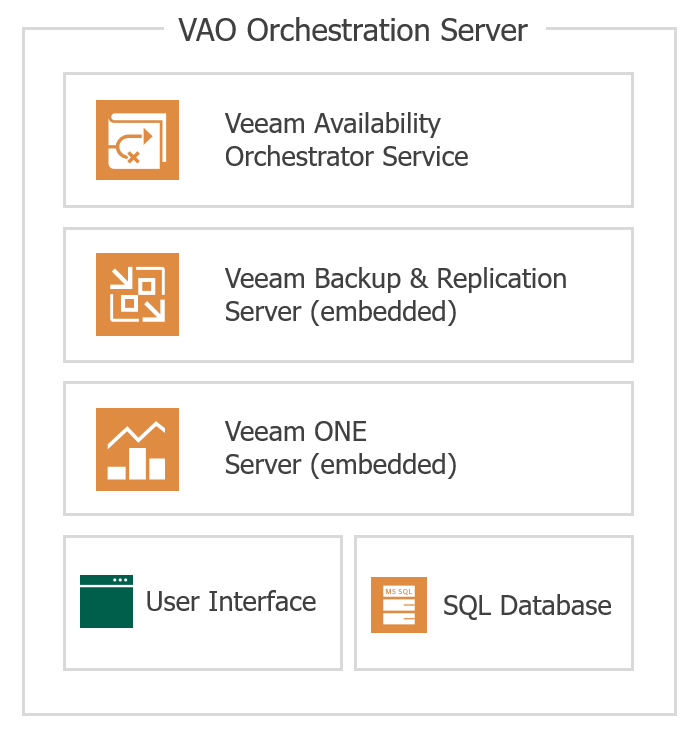 This is an archive version of the document. To get the most up-to-date information, see the current version.
This is an archive version of the document. To get the most up-to-date information, see the current version.Architecture Overview
This section provides information on the VAO architecture and its components, and describes the most common deployment scenarios. The main components in the VAO infrastructure are:
- Veeam Availability Orchestrator Server
- Veeam Backup & Replication Servers
- NetApp Storage Systems
- vCenter Servers
Veeam Availability Orchestrator Server
The VAO server is the configuration, administration and management core of the VAO infrastructure. The VAO server performs all orchestration actions. This is where orchestration plans are created, stored, tested and executed. Internally, the VAO server is comprised of the following components:
- VAO Server Service — is responsible for managing orchestration plans, and administering user roles and permissions.
- VAO UI — is a web-based UI that allows users to interact with the VAO Service, and to perform various configuration and administration actions. In the VAO UI, orchestration plans are designed, checked, tested and executed.
- Veeam Backup & Replication Server (embedded) — is included in the VAO server to supply Veeam PowerShell libraries and support certain DR scenarios.
- Veeam ONE Server (embedded) — handles the ONE Business View engine to gather VM inventory. This is a custom edition of Veeam ONE that should not be used for other monitoring or reporting functions.
- SQL Server — is used to host configuration data, VM inventory and plan definitions. A SQL Server Express instance can be installed locally with other VAO components. However, for best performance and scalability, SQL Server Enterprise edition is recommended, which may be a remote server.
All VAO components can be deployed on a single Windows-based physical or virtual machine using the unified installer.
Important |
Installation of the VAO server on a machine already running standalone versions of Veeam Backup & Replication and Veeam ONE is not supported. |
Veeam Backup & Replication Servers
If you already have Veeam Backup & Replication servers present in your environment, deploy a VAO agent to each of these servers to orchestrate the recovery of protected VMs.
Note |
Best practice recommends that the Veeam Backup & Replication server that runs backup and replication jobs is located in the DR site. This helps you ensure that the server will not be itself lost as part of a production site outage. |
You can also use the Veeam Backup & Replication servers to create and transfer storage snapshots. For more information, see the Veeam Backup & Replication User Guide, section Snapshot Orchestration.
All NetApp storage systems must be connected to the VAO server. That is, you must connect both storage virtual machines that manage volumes hosting VM disks and configuration files, and storage virtual machines that manage volumes storing replicated data.
Note |
You can connect only storage virtual machines to the VAO server. Connections to NetApp clusters and nodes are not supported. |
All vCenter Servers that manage protected VMs must be connected to the VAO server.
